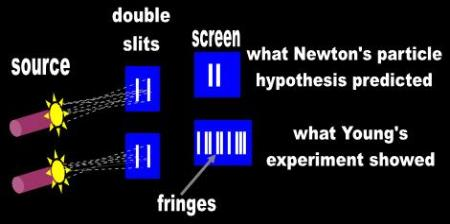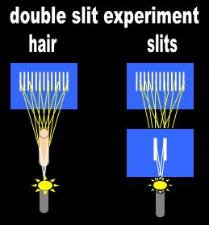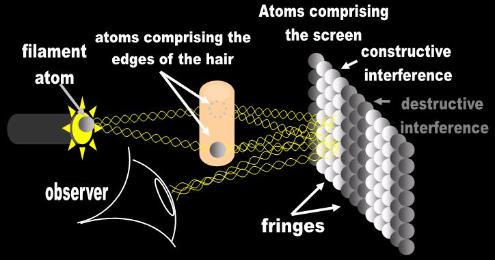Young’s slit experiment
In 1801, Young carried out an experiment where he passed light through two narrow slits cut into a partition and projected the beam onto a screen. If light consisted of a stream of bullets as Newton had suggested, the observer would expect to see two bright lines of light reflected on the screen. Instead, Young observed an entire band of bright and dark stripes. He reported his results in terms of waves, and was able to calculate the wavelengths of the beam. Young’s slit experiment became the first major observational milestone to place in doubt Newton’s corpuscular hypothesis. It appeared, after all, that Newton’s intuition about light not bending around corners was wrong.
If the source of light were a machine gun, we should observe only two slits marked on the wall where the bullets strike. This is what Newton’s corpuscular theory predicted. Young observed, instead, a series of bright and dark bands (fringes).

Let’s assume that light consists of a pair of torqued threads and that every atom in the Universe is connected to all others via these ropes. The correct interpretation of the slit experiment now follows more naturally. Before we have ignition, the atoms constituting the flashlight, the hair, the air, and the screen are already interconnected by continuously torquing threads. When you turn the laser pointer on, the atoms comprising the filament receive a stimulus and begin to pump faster. An increase in frequency translates into shorter links and light comes within visible range. This signal travels to the atoms comprising the sides of the hair which relay them onto the screen. The signal traveling to the screen does so along EM ropes that bind hair atoms to screen atoms. If the ropes arriving at a screen atom from different sides of the hair are out of phase, the screen atom will not be stimulated. We have destructive interference. Otherwise, we have constructive interference.
If the source of light were a machine gun, we should observe only two slits marked on the wall where the bullets strike. This is what Newton’s corpuscular theory predicted. Young observed, instead, a series of bright and dark bands (fringes).

Stimulated atoms in the filament emit torsion signals at a higher frequency to atoms on the side of the hair which RELAY the signal to the atoms on the screen. Where signals arrive out of phase we have destructive interference. Where they arrive in phase, we have constructive interference. These signals are re-emitted along EM ropes interconnecting screen atoms with the atoms that constitute the observer’s eyes
